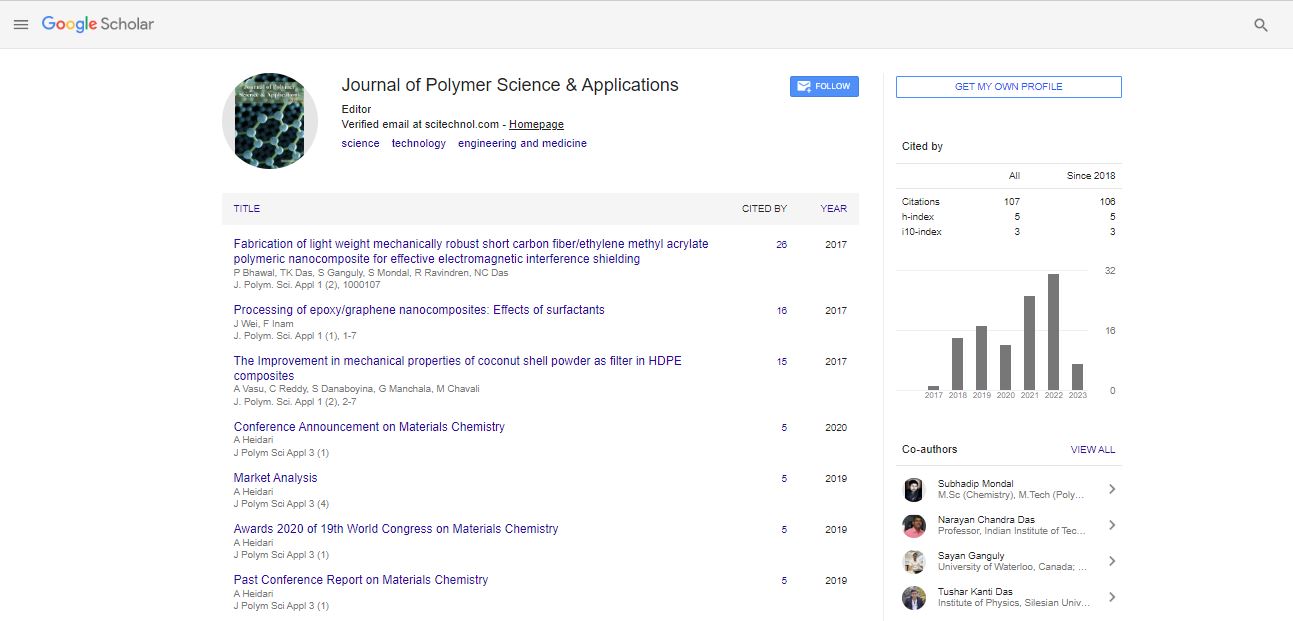Perspective, J Nanomater Mol Nanotechnol Vol: 7 Issue: 4
Atom Transfer Radical Polymerization (ATRP): Conversing Polymer Synthesis
Marco Isse*
1Department of Chemical Sciences, University of Padova, Padova, Italy
*Corresponding Author: Marco Isse,
Department of Chemical Sciences,
University of Padova, Padova, Italy
E-mail: issemarco@gmail.com
Received date: 20 November, 2023 Manuscript No. JPSA-24-123855;
Editor assigned date: 22 November, 2023, PreQC No. JPSA-24-123855 (PQ);
Reviewed date: 06 December, 2023, QC No. JPSA-24-123855;
Revised date: 13 December, 2023, Manuscript No. JPSA-24-123855 (R);
Published date: 20 December, 2023, DOI: 10.4172/Jpsa.1000145
Citation: Isse M (2023) Atom Transfer Radical Polymerization (ATRP): Conversing Polymer Synthesis. J Polym Sci Appl 7:4.
Description
Polymer chemistry has witnessed significant advancements over the years, and one of the groundbreaking techniques that have revolutionized the field is Atom Transfer Radical Polymerization (ATRP). ATRP has become a versatile and widely adopted method for the controlled synthesis of polymers with precisely defined structures. This technique has opened new avenues in the design and application of polymers for various industrial and scientific purposes.
ATRP belongs to the family of controlled/living radical polymerization techniques, which aim to achieve control over the polymerization process, resulting in polymers with predetermined molecular weights and narrow molecular weight distributions. Unlike traditional radical polymerization, which often yields polymers with broad molecular weight distributions and poorly defined structures, ATRP offers a more controlled and predictable approach to polymer synthesis.
The fundamental principle of ATRP involves the dynamic equilibrium between dormant and active species, allowing the controlled growth of polymer chains. The key players in ATRP are the transition metal catalyst, a halogenated initiator, and a reducing agent. Common transition metals used in ATRP include copper, iron, and ruthenium, among others. The halogenated initiator consists of a polymerizable unit, such as a vinyl or acrylate group, and a halogen atom, typically chlorine or bromine. The reducing agent facilitates the regeneration of the dormant species, allowing for the continuation of the polymerization process.
One of the remarkable features of ATRP is its ability to control the polymer chain length by manipulating the ratio of the catalyst to the initiator. This control enables the synthesis of polymers with welldefined molecular weights and specific functionalities. The versatility of ATRP has been demonstrated in the synthesis of a wide range of polymers, including homopolymers, block copolymers, and gradient copolymers.
The controlled nature of ATRP has significant implications for the design of advanced materials with tailored properties. For example, the synthesis of block copolymers with distinct blocks of different chemical compositions allows researchers to create materials with a combination of properties from each block. This versatility has found applications in various fields, including drug delivery, coatings, adhesives, and biomedical devices.
Moreover, ATRP has facilitated the development of functional polymers with precise architectures. By incorporating monomers with specific functional groups, such as hydroxyl, carboxyl, or amine groups, into the polymer structure, researchers can design polymers with desired properties, such as enhanced adhesion, biocompatibility, or responsiveness to external stimuli.
The widespread adoption of ATRP can also be attributed to its compatibility with a variety of monomers, including acrylates, methacrylates, styrenes, and vinyl acetate, among others. This versatility allows researchers to tailor the properties of the resulting polymers to meet the requirements of a particular application.
In addition to its synthetic versatility, ATRP has demonstrated excellent control over the polymerization kinetics, making it suitable for both laboratory-scale research and industrial production. The ability to scale up ATRP processes while maintaining control over the polymerization parameters has paved the way for the large-scale production of advanced materials with consistent quality.
Despite its numerous advantages, ATRP does have some limitations and challenges. One notable limitation is the potential contamination of the final polymer with trace amounts of metal catalyst. Efforts have been made to address this issue through the development of metal-free ATRP variants or post-polymerization purification techniques.
Atom Transfer Radical Polymerization has emerged as a transformative technique in the realm of polymer chemistry. Its ability to provide control over the synthesis of polymers with well-defined structures has led to the creation of a vast array of materials with tailored properties. The versatility of ATRP in terms of monomer compatibility, polymer architectures, and scalability has made it a goto method for researchers and industrial practitioners alike. As advancements in polymer science continue, ATRP is likely to play a pivotal role in the development of new materials and applications, further solidifying its place in the pantheon of revolutionary polymerization techniques.Top of Form
 Spanish
Spanish  Chinese
Chinese  Russian
Russian  German
German  French
French  Japanese
Japanese  Portuguese
Portuguese  Hindi
Hindi 